KABI SACRED SITES - PROTECTING CULTURAL HERITAGE
DJAKI KUNDU Page under construction. Information and images are published with permission of Sovereign Kabi Elders.
Djaki Kundu (Rocky Ridge in English) is an ancient Kabi sacred site on the outskirts of Gympie. It is a very culturally significant sacred landscape constructed thousands of years ago by Kabi Ancestors. The sacred site contains a powerful healing crystal. Kabi Elders believe the crystal must be protected and not disturbed, and it has the power to kill those who touch or move it.
Below Wit-boooka Kabi, one of the tribal guardians of Djaki Kundu, at one of the remaining stone terraced structures built by his Kabi ancestors.
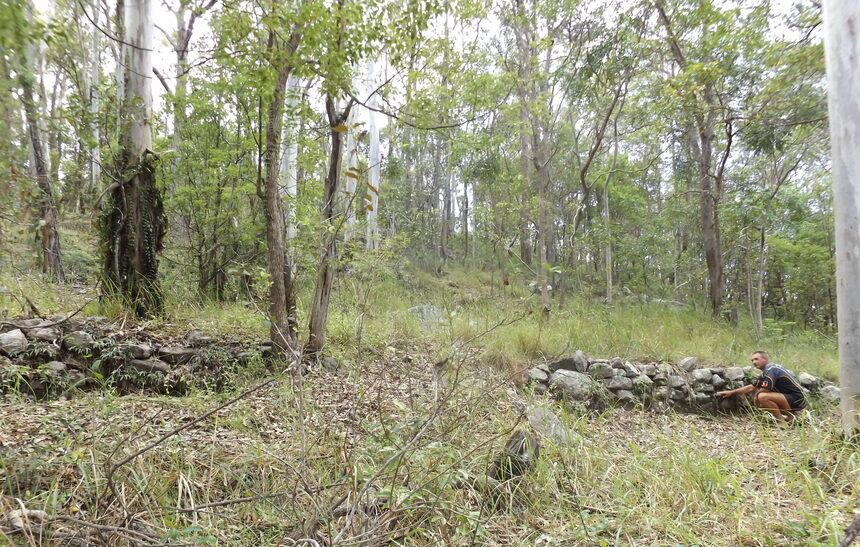
Djaki Kundu, known as 'Rocky Ridge' in English, is an ancient 'terraced' hill, which is integral to Kabi Kabi Dream-time stories relating to the Star Ancestors. Songlines from other parts of the country lead to, or pass through Djaki Kundu, and it is a gathering place connected to the Seven sisters dreaming, and the creation of Kabi. The sacred site holds the Kabi connection to country and to the star Ancestors. Elders pass down the story of the 'Seven Sisters' (of the Pleiades star system) who came to earth, chased by the three men in the 'Big Canoe' (the three 'belt stars' of the Orion constellation). Djaki Kundu is known as the place for Kabi people to commune with the spirits of their Ancestors.
The connection of the Kabi Kabi Tribes to the Pleiades is independently supported by an account of the meaning of 'Kabi Kabi', which was documented by Presbyterian missionaries in the 1923, and was re-published in the Cairns post in 1938. Namatu (crocodile) who resided at Mapoon was regarded as an authority on 'Aboriginal ' lore and history. Namatu he stated in 1923:
'The Pleiades are Kabi-kabi, meaning a group of girls, and other stars are named after similar animals - after snakes and emus'.
Below: Extract from Cairns Post page 10, 16th November 1938. Below: Kabi tribal relic from Djaki Kundu.
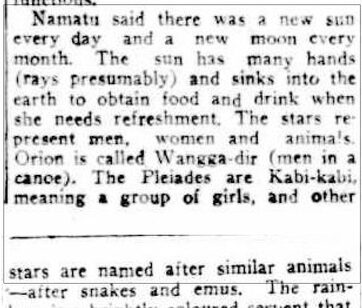
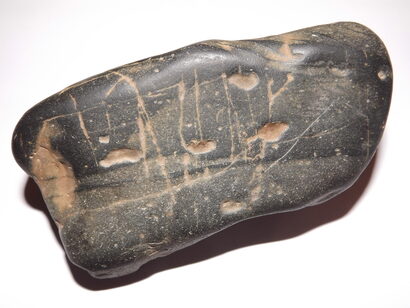
Djaki Kundu is also known to some people as 'The Gympie Pyramid'. Many unsubstantiated theories have been published in the past as to the origins of the stone constructions, however none of the 'researchers' of these theories consulted with the Kabi tribal guardians and knowledge keepers of Djaki Kundu when formulating their colourful theories.
The sacred site is visited by people from all over the world who regard it as an ancient and mysterious place which should be preserved. Though many people come to the sacred site few are aware of it's true significance.
Below: An upper stone 'terrace' wall at Djaki Kundu (Rocky Ridge). Below: Grooves for preparing bush foods and medicines, and sharpening tools.


THE HISTORY:
The Kabi Kabi speaking peoples and the Sovereign Kabi Tribes of South East Queensland have struggled like all First Nation Peoples, to protect their sacred sites from destruction, ever since the first 'white settlers' set foot on Kabi Bunya Djha, (Kabi Bunya Country).
In 1842, Governor Gipps enacted the 'Bunya Proclamation' which prohibited unauthorised settlement by citizens of the Crown, of any of the lands north of Moreton Bay where Bunya trees grow. The Bunya Proclamation also outlawed the felling of trees.1 This Lawful enactment has never been repealed.
Below: The Bunya Proclamation of 1842.

THE POLITICS:
The Sovereign Kabi Tribes of the Gympie region never sold or gave their Country to 'The British Crown' or anyone else, and therefore remain the Sovereign Tribal Owners of the sacred site at Rocky Ridge. It is part of Sovereign Kabi Djakurpa Law that sacred sites must be protected. It seems the Queensland Government has other ideas.......
Despite being informed of the significance of the site to the Kabi Kabi peoples, Australian governments planned the destruction of the site at Rocky Ridge many years ago, as part of the plans for highway upgrades in Queensland. The Sovereign KabiTribes of the Gympie Region have made it clear that they are not trying to obstruct government with their plans to upgrade roads, however Kabi people insist that Kabi spiritual and religious beliefs and ceremonial practice must be respected (as is a basic human right). To ensure the continuation of Kabi cultural, spiritual and religious practice sacred sites must be protected, and alternate routes must be negotiated for highway upgrades, and destructive 'development projects' must cease.
Australian governments have no permission to interfere with any Kabi Kabi sacred sites, as they were never sold or given to the Crown, and therefore, as acknowledged in British and Australian law, the Crown and Parliament have no lawful jurisdiction over Kabi land.2
Currently the Premier of Queensland recognises the Kabi situation, however refuses to make comment.
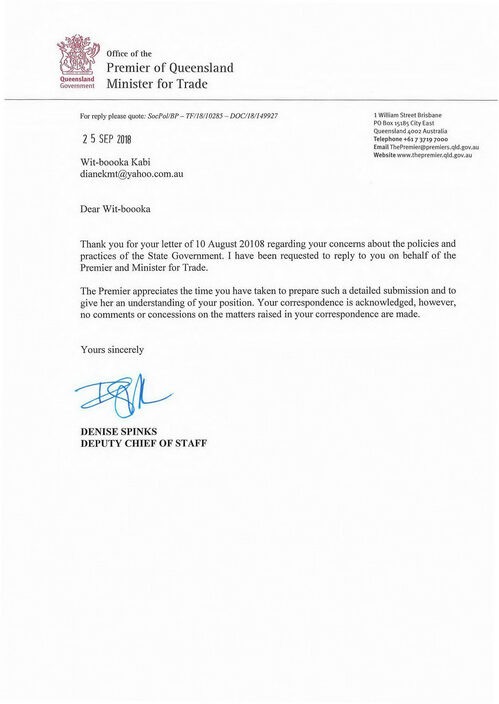
On Thursday the 18th June 2015, workers contracted by the Queensland Department of Transport and Main Roads, were discovered drilling holes in the sacred site, by Kabi Kabi Tomlinson family representative and Sovereign Owner of the Gympie region, Wit-boooka Kabi. Wit-boooka explained to the workers that they were trespassing and destroying sacred land, in defiance of tribal law, Acts of the Crown, and Queensland cultural heritage laws. He exercised his rights as a Sovereign Owner, and demanded that the trespassers leave. Kabi Kabi Elders Aunty Bev Muckan and Aunty Bucky Tomlinson joined Wit-boooka to publicise the illegal actions of Government agencies, who are attempting to destroy an ancient and sacred cultural heritage site of significance to the Kabi Kabi Sovereign owners of the Gympie Region. The destruction of 'Aboriginal Cultural Heritage' is an offence under laws passed by Parliament in the Queensland Cultural Heritage Act 2003.3 Kabi Sovereign Owners from Gympie are pursuing the matter with Government.
Image below shows an extract from the 20/06/2015 edition of the Gympie Times, regarding the Kabi Kabi position on the attempted destruction of sacred sites.4
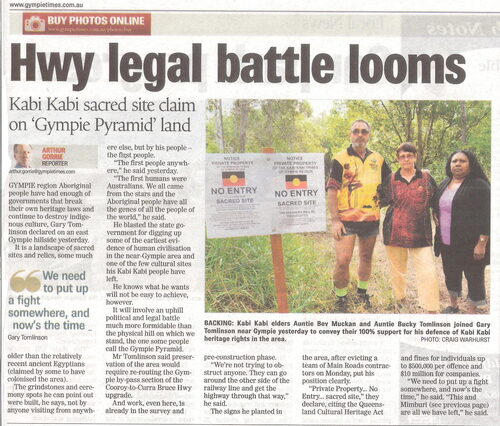
The Queensland Government also listed for public sale, another very important sacred place in the Mary River Valley known as Mimburi. Recently the sacred lands at Mimburi were advertised for private sale by the state government, despite the continuing use of the many sacred sites, and utilisation of the property for youth, education, and cultural activities by Kabi Kabi peoples of the Mimburi Upper Mary Aboriginal Association. Mimburi was previously set aside by the government for Kabi Kabi use, due to it's high cultural significance. The property has now been given to a non Kabi school, and Kabi tribes are concerned that such culturally significant areas are knowingly alienated from tribal use, and sacred sites and areas are at risk of destruction.
The extract below from the 20/06/2015 edition of the Gympie Times mentions the fact the property was removed from sale.5
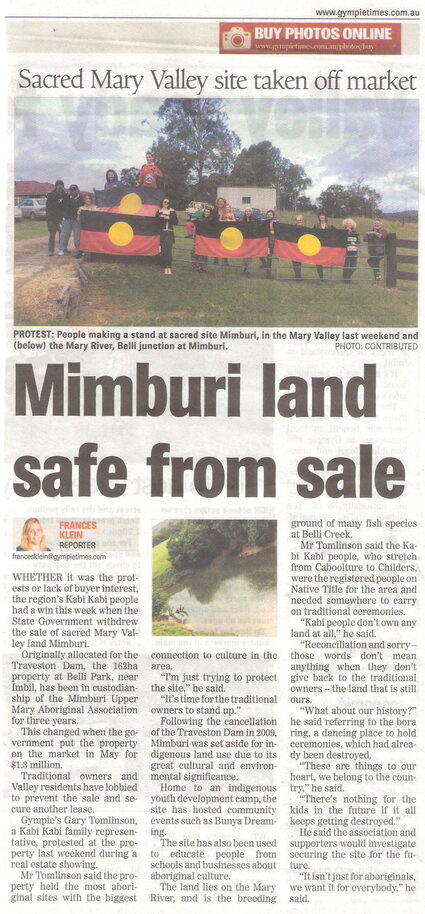
The members of the Sovereign Native Tribes of the Kabi First Nation State are currently involved in legal actions involving Australian Government authorities. Sovereign Kabi tribal Law man Wit-boooka was incarcerated for two months, as a result of being arrested. He was charged with trespass, public nuisance and numerous assaults along with his cousin Mervyn, and Diane of Djaki Widjung, who were both bailed with the same charges. This matter occurred when the three Kabi Sovereign Tribal Representatives exercised their spiritual and religious obligation to attended Gympie Regional Council Chambers to present a Tribal eviction notice to the Council on 31st May 2016, and to talk with the administrators, in an attempt to persuade local government administrators to cease their unlawful acts, which include the destruction of sacred sites and complicity in the acts of genocide against the Kabi Nation. Wit-boooka, Mervyn and Diane all suffered bodily harm as a result of the 'interaction'.
After two and a half years the matters are still continuing in Gympie Courts. Video footage recorded on the day will assist to reveal the truth.
REFERENCES
1 King William the Fourth, 'Letters Patent Erecting and Establishing the Province of South Australia, 19 February 1836', Available from Australian Government Founding Documents website: http://foundingdocs.gov.au/resources/transcripts/sa2_doc_1836.pdf
Queen Victoria, 'The Pacific Islander Protection Act 1875 UK', Ozcase Queensland Historical Legal Collection website, available from:
http://ozcase.library.qut.edu.au/qhlc/documents/qr_paci_pacific_1875_38-39_Vic_c51.pdf
2 Bunya Proclamation 1842
3 Queensland Cultural Heritage Act.
4 Arthur Gorrie, 'Hwy Legal Battle Looms', Gympie Times, June 20, 2015, p. 5.
5 Francis Klein, 'Mimburi land safe from sale', Gympie Times, June 20, 2015, p. 4.